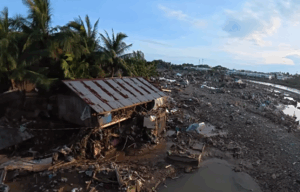MANILA — Vast stretches of northern and central Philippines lay underwater on Monday after Typhoon Uwan (Fung-wong), one of the most powerful storms to hit the country this year, tore across the archipelago over the weekend, killing at least five people and forcing more than 1.4 million from their homes.
The storm made landfall on the eastern coast Sunday evening as a super typhoon, bringing sustained winds of over 200 kilometers per hour and torrential rains that inundated entire villages and left cities like Tuguegarao in Cagayan province completely submerged. Power outages affected dozens of towns as rescue crews waded through chest-deep waters to reach stranded families.
“We didn’t think the water would reach us. It had never risen this high before,” said Mark Lamer, a 24-year-old resident of Tuao, Cagayan, where the Chico River overflowed its banks following flash floods from nearby Apayao province.
Deadly Landslides and Rising Death Toll
In northern Luzon, landslides killed twin five-year-old children and an elderly man after days of heavy monsoon rains saturated the soil ahead of Uwan’s arrival. Authorities also confirmed fatalities in Samar and Catanduanes, islands still reeling from Typhoon Tino (Kalmaegi), which struck just days earlier and killed at least 224 people.
President Ferdinand Marcos Jr. said the government’s state of national calamity declaration, first issued after Typhoon Tino, would be extended for a full year to speed up relief and reconstruction. Schools and government offices across Luzon, including the capital Manila, were shuttered Monday as cleanup efforts stretched from Cagayan in the north to Bicol in the south.
Government and Global Response
Abroad, the United Nations Office for the Coordination of Humanitarian Affairs (OCHA) expressed concern over “the compounding effects of consecutive typhoons,” while the Japan Meteorological Agency noted that the storm’s path and intensity were “consistent with the observed strengthening of tropical cyclones in warmer oceans.”
Rescue operations were ongoing across the country, with military and civilian teams using boats and helicopters to reach flooded communities. International aid groups, including the Red Cross and Save the Children, began mobilizing relief supplies to evacuation centers housing thousands of displaced families.
Climate Change Intensifying Tropical Storms
Meteorologists and climate scientists echoed the warning: global heating is making tropical storms more frequent and more intense. “Warmer air holds more moisture, which means heavier rainfall and greater flooding risk,” said Dr. Maria del Rosario, a climatologist at the University of the Philippines.
Recent studies from the World Meteorological Organization (WMO) and NOAA have shown that the Pacific typhoon belt is experiencing a measurable increase in rapid-intensification events — storms that gain destructive power in less than 24 hours — driven by warming ocean temperatures.
Taiwan on High Alert as Uwan Moves North
Uwan is now heading north toward Taiwan, where authorities have issued severe weather alerts. The Central Weather Administration in Taipei forecast up to 350 millimeters (14 inches) of rainfall over 24 hours in the island’s northern and eastern regions. Local officials said nearly 5,000 people were being evacuated in Hualien County, recalling a 2019 disaster in which a barrier lake burst during a similar deluge.
Across Asia, emergency agencies are preparing for what meteorologists warn could be a longer and harsher typhoon season. As the Philippines begins recovery from back-to-back disasters, experts say the region’s growing vulnerability to climate-fueled storms is once again on full display — and likely to deepen without urgent global action. (hb)


